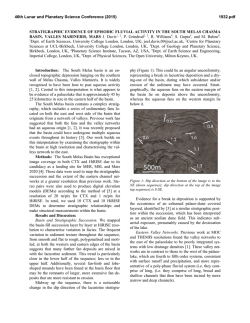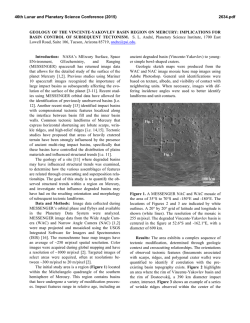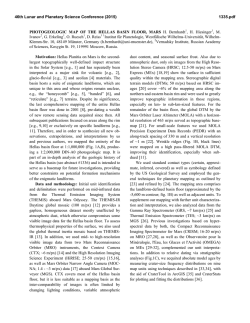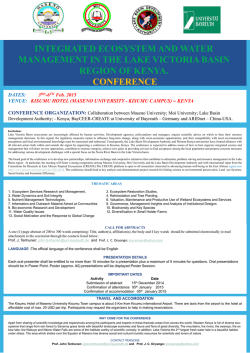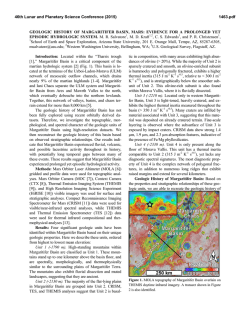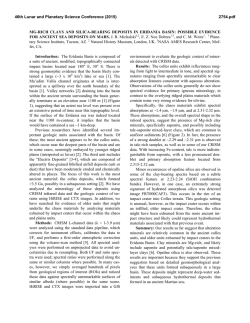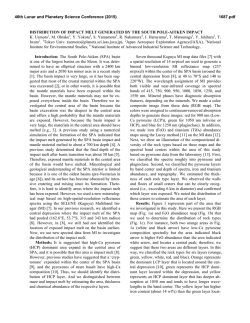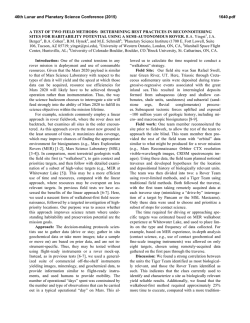
early triassic temnospondyl skull fragments from
Revista Brasileira de Paleontologia 8(2):165-172, Maio/Agosto 2005 © 2005 by the Sociedade Brasileira de Paleontologia EARLY TRIASSIC TEMNOSPONDYL SKULL FRAGMENTS FROM SOUTHERN SOUTH AMERICA (PARANÁ BASIN, BRAZIL) SÉRGIO DIAS-DA-SILVA Museu de Ciência e Tecnologia, PUCRS, Av. Ipiranga 6681, 90.619-900, Porto Alegre, Brazil. Current Address: Universidade Federal do Tocantins, Campus de Porto Nacional, Jardim dos Ipês, Cx. P. 136, 77.500-000. Porto Nacional, Brazil. [email protected] CLAUDIA MARSICANO Departamento de Cs. Geologicas, UBA, Ciudad Universitaria Pab. II, C1428DHE, Buenos Aires. Argentina. [email protected] CESAR LEANDRO SCHULTZ Instituto de Geociências, Departamento de Paleontologia e Estratigrafia, UFRGS, Av. Bento Gonçalves, 9500, 91.540-000. Porto Alegre, Brazil. [email protected] ABSTRACT– Fragmentary eotriassic temnospondyl skull remains have been recovered from levels of the Sanga do Cabral Formation in the Paraná Basin. Despite the fragmentary nature of the material, several specimens can be identified and described herein. Some are tentatively attributed to rhytidosteids, based on the ornamentation of the dermal bones, and others are identified simply as Temnospondyli incertae sedis. The rhytidosteids seem to have dominated aquatic environments during the Early Triassic and some paleoecological implications are discussed. In the Upper Permian, medium-large rhinesuchid faunas inhabited the Paraná Basin and by the end of Paleozoic they become extinct. During the Lower Triassic, they were replaced, by a quite abundant fauna mainly represented by small rhytidosteids. The uppermost Permian strata in the Paraná Basin are represented by the Pirambóia Formation which was deposited under aeolian conditions, so the environmental conditions had changed from humid to arid. This could help to explain the ‘sudden’ disappearance of the rhinesuchids from this depocenter at the end of Permian. When more humid conditions returned to this basin during the Early Triassic, the rhytidosteids might had been the first group to arrive. However, an alternative explanation is that this abundance of rhytidosteids be a taphonomic artifact that only preserved animals from selected habitats. Key words: Temnospondyli, Rhytidosteidae, Lower Triassic, South America, Paraná Basin. RESUMO – Restos de fragmentos cranianos de temnospôndilos eotriássicos foram coletados na Formação Sanga do Cabral, pertencente à bacia do Paraná. Embora fragmentários, alguns deles são descritos e identificados no presente trabalho. Vários fragmentos foram tentativamente atribuídos a ritidosteídeos, com base na ornamentação característica e diagnóstica dos ossos dérmicos, enquanto outros fragmentos foram somente identificados como Temnospondyli incertae sedis. Os ritidosteídeos parecem ter dominado os ambientes aquáticos durante o Eotriássico e assim algumas considerações são discutidas. No Permiano Superior, rinessuquídeos de tamanho médio a grande habitaram a Bacia do Paraná tendo se tornado extintos no final do Paleozóico. Durante o Neotriássico, foram substituídos por uma fauna abundante representada em sua maioria por pequenos ritidosteídeos. Os níveis superiores do Permiano da Bacia do Paraná são representados pela Formação Pirambóia, depositada predominantemente sob condições eólicas. Essa mudança ambiental de úmido para árido poderia explicar o ‘súbito’ desaparecimento dos rinessuquídeos deste depocentro no final do Permiano. Quando condições mais úmidas retornaram a esta bacia durante o Neotriássico, os ritidosteídeos foram os primeiros a colonizar esta área. Contudo, uma explicação alternativa seria que esta abundância de ritidosteídeos corresponderia a um artefato tafonômico, em que se preservariam apenas animais de ambientes selecionados. Palavras-chave: Temnospondyli, Rhytidosteidae, Triássico Inferior, América do Sul, bacia do Paraná. 165 166 REVISTA BRASILEIRA DE PALEONTOLOGIA, 8(2), 2005 S A V O R P Figure 1. Location of the main outcrops of the Sanga do Cabral Formation. Hatching indicates the extension of the Paraná Basin within and outside Rio Grande do Sul State. DIAS-DA-SILVA ET AL. – EARLY TRIASSIC TEMNOSPONDYLI 167 S A V O R P Figure 2. A, UFRGS PV0237T in dorsal view; B, UFRGS PV0250T in dorsal view; C, UFRGS PV0250 in ventral view; D, UFRGS PV0253T in dorsal view; E, UFRGS PV0253T in ventral view; F, UFRGS PV0257 in dorsal view. Scale bar = 1 cm. INTRODUCTION The fossil record of temnospondyls in South America is generally fragmentary and incomplete. Lower Permian temnospondyls are known only from Brazil, described from two different basins. The archegosauroid Prionosuchus plummeri (Price, 1948; Cox & Hutchinson, 1991) was the first temnospondyl material described from Brazil and comes from the Parnaíba Basin (Pedra de Fogo Formation) in the northeast part of the country. Other specimens come from the Paraná Basin (Rio do Rasto Formation) in southernmost Brazil. A rhinesuchid, Australerpeton cosgriffi (Barberena, 1998), an archegosauroid, Bageherpeton longignathus (Dias & Barberena, 2001) and an unclassified short-snouted rhinesuchoid (Barberena & Dias, 1998) were described from this Basin. Lower Triassic temnospondyls are also known from the Paraná Basin and they were recorded from levels that crop out both in Brasil (Sanga do Cabral Formation) and Uruguay (Buena Vista Formaton) that are considered lateral equivalents (França et al., 1995 and Andreis et al., 1996). At present, ‘lydekkerinids’ and rhytidosteids have been recognized from the Brazilian Lower Triassic (Lavina & Barberena, 1985; Dias-da-silva & Schultz, 1999) and a dvinosaurid temnospondyl from the Lower Triassic of Uruguay (Marsicano et al., 2000). Finally, Upper Triassic levels from Argentina have yielded several temnospondyl remains mainly represented by chigutisaurids (Bonaparte, 1963; Marsicano, 1999; Warren & Marsicano, 2000). The Lower Triassic temnospondyl record of the Sanga do Cabral Formation (restricted to Rio Grande do Sul State, Southern Brazil; see Figure 1) is fairly abundant and based on fragments that represent mainly small animals. This unit is correlated with the ‘impoverished zone’ (Procolophon subzone sensu Neveling et al.,1999) from the Karoo Basin in South Africa (Abdala et al.,2002; Cisneros & Schultz, 2002). The temnospondyl content of the Sanga do Cabral Formation was recently reviewed to a coarse taxonomic level, though it shows the presence of an already quite diversified stereospondyl fauna (Dias-da-Silva, 2003). The aim of this paper is to present a description of all fragmentary temnospondyl cranial material from the Sanga do Cabral Formation as it provides valuable information concerning the early diversification of stereospondyls in the Paraná Basin. Moreover, renewed study of tetrapod remains in the Permo-Triassic of this Basin could result in a new perspective on the tetrapod faunal turnover during the Permo-Triassic boundary in Gondwana. The present paper deals with description of several dermal skull fragments coming from Sanga do Cabral Formation. It also describes materials collected, prepared and/or reviewed by Dias-da-Silva in his PhD Thesis (Dias-da-Silva, 2003). MATERIAL AND METHODS Most specimens were collected mainly in Dilermando Aguiar, while others come from Mata (UFRGS PV0651T). Both are municipalities in the central region of Rio Grande do Sul state. Additional materials, also from the Sanga do Cabral 168 REVISTA BRASILEIRA DE PALEONTOLOGIA, 8(2), 2005 S A V O R P Figure 3. UFRGS PV0327T. A. lateral view; B. Medial view; C. ventral view. Scale bar = 1 cm. Figure 4. A, UFRGS PV0361T, dorsal view; B, UFRGS PV0362T, dorsal view. Scale bar = 1 cm. Formation, represent a new rhytidosteid taxon (Dias-da-Silva et al., submitted) Institutional Abbreviations. UFRGS PV-T, Universidade Federal do Rio Grande do Sul, Laboratório de Paleovertebrados, Porto Alegre, Brazil; MCN- PV, Fundação Zoobotânica do Estado do Rio Grande do Sul, Porto Alegre, Brazil. Anatomical abreviations. apf, alar process of jugal; ar, ascending ramus of pterygoid; gl, glenoid; ios, Infraorbital sulcus; p, pustule; pga, postglenoid area; plt, pleurodont teeth; pp, postparietal; rc, ridges and crests; sol, supraorbital lamina; st, supratemporal; t, tabular. DESCRIPTION TEMNOSPONDYLI RHYTIDOSTEIDAE UFRGS PV0237T. Dermal skull fragment, probably from the skull table or from the cheek (a quadratojugal or jugal), with a midline suture. The sculpture pattern is similar to that found in rhytidosteids (spider-web sensu Cosgriff & Zawiskie, 1979), with nodules or pustules at points of junction and bifurcation of ridges and sulci (Figure 2A). DIAS-DA-SILVA ET AL. – EARLY TRIASSIC TEMNOSPONDYLI S A V O R P 169 Figure 5.Two mandibular fragments. A, UFRGS PV0506T in lingual view; B, UFRGS PV0506T in labial view; C, UFRGS PV0651T in lingual view; D, UFRGS PV0651T in labial view. Scale bar = 2 cm. UFRGS PV0253T. Dermal skull fragment without preserved sutures. The ornamentation shows the characteristic pattern found in rhytidosteids (nodules and pustules at points of junction and bifurcation of crests and ridges). Ventrally, a deep sulcus is present (Figure 2D-E). UFRGS PV0257T. Dermal skull fragment without sutures. Part of the ossification center is present, surrounded by radiating ridges. Again, the sculpturing of this fragment is consistent with that found in rhytidosteids (Figure 2F). UFRGS PV0327T. A dermal skull fragment composed of an ornamented jugal with its alar process preserved in ventral view. Its rhytidosteid ornamentation is clearly visible, as well as the bifurcated infraorbital canal of the lateral line system. Ventrally, the anterior border of the subtemporal fossa is preserved (the posterior margin of the alar process). The shape of the alar process is a right angled triangle, very similar to that found in a new rhytidosteid taxon (Dias-da-Silva et al., submitted), but UFRGS PV0327T differs by presenting the posterior limit of the fragment slightly curved (Figure 3AC). UFRGS PV0361T. Fragment similar to UFRGS PV0257T, where part of the ossification center is present, surrounded by radiating ridges where nodes or pustules are present at their points of junction and bifurcation (Figure 4A). UFRGS PV0362T. Dermal fragment composed of two partial bones of the skull roof that preserves the border of an opening, such as the orbits, external nares or even the otic notch. As in several fragments described above, the ornamentation is that usually found in rhytidosteids (Figure 4B). MCN PV2606. Skull fragment that includes a palatal fragment and three attached dorsoventrally compressed dermal skull bones (postparietal, supratemporal and tabular) (Figure 6A). The palatal fragment is composed of the corpus of the left pterygoid and the ascending ramus (broken medially and posteriorly) (Figure 6B). The ascending ramus of the pterygoid curves inwardly proximally in dorsal and occipital view. It is firmly connected to the skull roof (Figure 6C, D). Close to the corpus of the pterygoid, and medially to its length, the ascending ramus shows two wide depressions, one anterior (better preserved) and one posterior (damaged during preparation and probably shallower than it appears to be). There is no sign of palatal denticles (shagreen) or ornamentation on the pterygoid corpus. The dermal skull bones (postparietal, supratemporal and tabular) show the ‘rhytidosteid’ pattern of ornamentation (see Figure 6a). The ascending ramus is not comparable to that described for members of this group of stereospondyls (see Warren & Black, 1985; Marsicano & Warren, 1998; Yates & Warren, 2000). 170 REVISTA BRASILEIRA DE PALEONTOLOGIA, 8(2), 2005 S A V O R P Figure 6. MCN PV2606. A, dorsal view; B, ventral view; C, Occipital view; D, Anterior view; E, Medial view. Scale bar = 2 cm. TEMNOSPONDYLI INCERTAE SEDIS UFRGS PV0250T. Maxillary fragment bearing 8 small pleurodont teeth, consistent with those usually found in stereospondyls. Santana (1992) identified this fragment as being part of the palate, whith part of the choana preserved. However, a more detailed examination of this fragment has revealed that the assumed margin of a choana is, in fact, a fracture, so it is not possible to define the exact position of this fragment along the maxilla. In lateral view, the sculpture pattern shows ridges and sulci without any sign of pustules (Figure 2C). UFRGS PV0506T and UFRGS PV0651T. Two badly preserved mandibular fragments broken very close to the anterior border of the glenoid fossa. Both fragments preserve the glenoid and postglenoid area (PGA sensu Jupp & Warren, 1986). These PGAs are well developed, but not to the extent found in more advanced stereospondyls (e. g. Rhytidosteidae and Chigutisauridae, among others). The dermal bones that face the labial view of both fragments are missing (Figure 5A-D) and there is no evidence of the oral, mandibular or acessory sulci. According to Jupp & Warren (1986), there are two types of postglenoid areas (PGA Type I and PGA Type II). The type I postglenoid area consists essencially of two bones, the articular and surangular. The type II postglenoid area consists primarily of the articular, surangular and angular. Since the bone sutures of the PGAs UFRGS PV0506 T and UFRGS PV0651 T are not preserved, their type is unknown. Moreover, as Damiani et al. (2001) pointed out, only a few studies deal with the range of variation of the mandible within any particular higher-level temnospondyl taxon. Even so, despite incomplete preservation of the material presented here, it resembles the mastodonsaurid mandibular fragment described by Damiani et al. (2001) from the Lower Triassic of South Africa (Lystrosaurus Assemblage Zone), especially concerning the degree of development of the PGA and the slope angle of the posterior ventral margin of the Brazilian mandibular fragment. In dorsal view, the shape of the glenoid fossa is also unknown, since the anterior border is broken. Unfortunately, the L-shaped characteristic glenoid fossa of mastodonsaurids also cannot be seen in the Brazilian material. Finally, the resemblance of these mandibular fragments to those found in mastodonsauroids is superficial (only the overall shape), since more informative characters (such as the relative position of the mandibular bones of the PGA) are unknown, so the taxonomic identity of these PGAs remains still uncertain. DISCUSSION Among the material above described, the specimens UFRGS PV0237T, UFRGS PV0253T, UFRGS PV0257T, UFRGS PV0327T, UFRGS PV0361T, UFRGS PV0362T and MCN PV2606, are tentatively assigned to Rhytidosteidae, based upon their characteristic ‘rhytidosteid’ornamentation. The specimens UFRGS PV0250T, UFRGS PV0506 T and UFRGS DIAS-DA-SILVA ET AL. – EARLY TRIASSIC TEMNOSPONDYLI PV0651T are assigned to Temnospondyli incertae sedis, because of the fragmentary nature of the material that precludes a more accurated identification. Despite the fragmentary nature of the material, some important points can be discussed. If the material belongs to rhytidosteids, they were fairly abundant during the deposition of Sanga do Cabral levels. In contrast, in other Early Triassic temnospondyl assemblages of Pangea they usually occur associated with other temnospondyl groups such as the Lydekkerinidae, Capitosauridae, Mastodonsauridae, Brachyopoidea, Micropholididae, Trematosauridae, Plagiosauridae (Anderson & Cruickshank, 1978; Kitching, 1978; Cosgriff, 1984; Schoch & Milner, 2000, among others). The Permian-Triassic boundary in the Paraná Basin is incomplete, since lowermost Triassic strata are missing. The Pirambóia Formation, of predominant aeolian deposition in Rio Grande do Sul State, represents the uppermost levels of Permian in Paraná Basin (Lavina et al., 1993; Lavina & Scherer, 1997). Until now, no fossil record was known from these levels. As mentioned above, the lowermost Triassic is not represented in the Paraná Basin as the Sanga do Cabral formation is dated as Upper Induan/Lower Olenekian (late Early Triassic) in age (the Procolophon Subzone sensu Neveling et al., 1999). If the dry conditions found in the Pirambóia Formation continued during the Early Triassic in South America, it is possible that only when the environment changed to more humid conditions could the temnospondyls return to the basin, being the rhytidosteids the first group to arrive. This could explain their predominance in Sanga do Cabral Formation. But this raises the question of why the rhytidosteids and not other groups. An alternative explanation is that the observed bias corresponds to a taphonomic artifact that only preserved animals from selected habitats. It is interesting to note that most preserved remains are of small individuals. After the dominance during the Upper Permian of relatively medium-large rhinesuchid temnospondyl faunas in the Paraná Basin, the Lower Triassic appears dominated by a quite abundant fauna mainly represented by small “rhytidosteids”. This explanation is highly speculative, and needs further corroboration. Nevertheless, an open niche with no competitors during the Early Triassic might have made easy the rhytidosteid colonization of the basin. New efforts in prospecting for new outcrops and improvement of collecting efforts of tetrapods from the Permian-Triassic levels in this part of Gondwana is needed. This will increase the amount of available data that might help to explain the pattern of the early diversification of stereospondyls in southern South America. support, and the MCT/PUCRS (Museu de Ciência e Tecnologia da Pontifícia Universidade Católica do Rio Grande do Sul) for facilities provided during the present study. REFERENCES Abdala, N.F.; Dias-da-Silva, S. & Cisneros, J. C. 2002. First Record of Non-Mammalian Cynodonts (Therapsida) in The Sanga do Cabral Formation (Early Triassic) of Southern Brazil. Paleontologia Africana, 38:93-98. Anderson, J.M. & Cruickshank, A.R.I. 1978. The biostratigraphy of the Permian and Triassic. A review of the classification and distribution of Permo-Triassic tetrapods. Palaeontologia Africana, 21:15-44. Andreis, R.; Ferrando, L. & Herbst, R. 1996. Terrenos Carboníferos y Pérmicos de la República Oriental del Uruguai. In: S. Archangelsky (ed.) El Sistema Pérmico en Argentina y Uruguai, Academia Nacional de Ciencias, Córdoba, p. 309-343. Barberena, M.C. 1998. Australerpeton cosgriffi n.g., n.sp., a Late Permian Rhinesuchoid amphibian from Brazil. Anais da Academia Brasileira de Ciências, 70(1):125-137. Barberena, M.C. & Dias, E.V. 1998. On the presence of a shortsnouted rhinesuchoid amphibian in the Rio do Rasto Formation (Late Permian of Paraná Basin, Brazil). Anais da Academia Brasileira de Ciências, 70(3):465-468. Bonaparte, J.F. 1963. Promastodonsaurus bellmanni n. g. et n. sp., capitosáurio del Triásico Medio de Argentina (Stereospondyli - Capitosauroidea). Ameghiniana, 3(3):67-78. Cisneros, J.C. & Schultz, C.L. 2002. Procolophon brasiliensis n. sp., a new procolophonid reptile from the Lower Triassic of southern Brazil. Neues Jahrbuch für Geologie und Paläontologie Monatshefte, 11:641-648. Cosgriff, J.W. 1984. The temnospondyl labyrinthodonts of the earliest Triassic. Journal of Vertebrate Paleontology, 4(1):3046. Cosgriff, J.W. & Zawiskie, J.M. 1979. A new species of the Rhytidosteidae from the Lystrosaurus Zone and a review of the Rhytidosteoidea. Palaeontologia Africana. 22:1-27. Cox, C. B. & Hutchinson, P., 1991. Fishes and amphibians from the Late Permian Pedra do Fogo Formation of Northern Brazil. Palaeontology, 34:561-573. Damiani, R. J.; Neveling, J. & Hancox, P. J. 2001. First record of a mastodonsaurid (Temnospondyli, Stereospondyli) from the Early Triassic Lystrosaurus Assemblage Zone (Karoo Basin) of South Africa. Neues Jahrbuch für Geologie und Paläontologie, Abhandlung, 221(1):133-144. Dias, E.V.; & Barberena, M.C. 2001. A temnospondyl amphibian from the Rio do Rasto Formation, Upper Permian of Southern Brazil. Anais da Academia Brasileira de Ciências, 73(1):135143. Dias-da-Silva, S. 2003. Temnospôndilos Eotriássicos da Bacia do Paraná: Descrição e Filogenia. Programa de Pós-graduação em Geociências, Universidade Federal do Rio Grande do Sul, Tese de Doutorado, 130 p. Dias-da-Silva, S. & Schultz, C.L. 1999. New procolophonids (Parareptilia, Procolophonoidea) and rhytidosteids (Amphibia, Temnospondyli) of Southern Brazilian Triassic. In: JORNADAS ARGENTINAS DE PALEONTOLOGIA DE VERTEBRADOS, 14, 1999. Neuquén, Ameghiniana, 36(1):99. França, A.; Milani, E.; Schneider, R.; Lopez, M.; Suares, S.; Santa Ana, H.; Wiens, F.; Ferreiro, O.; Rossello, E.; Bianucci, H.; Flores, R.; Vistalli, M.; Fernandez-Seveso, F.; Fuenzalida, R. & S A V O R P ACKNOWLEDGEMENTS We would like to thank Jorge Ferigolo from FZB/RS (Fundação Zoobotânica do Estado do Rio Grande do Sul) for the loan of part of the temnospondyl material. The first author also would like to thank the CNPq (Conselho Nacional de Desenvolvimento Científico e Tecnológico) for financial 171 172 REVISTA BRASILEIRA DE PALEONTOLOGIA, 8(2), 2005 Muñoz, N. 1995. Phanerozoic correlation in Southern South America, A. J. Tankard, R. Suárez & H. Welsink, eds., AAPG Memoir, 62:129-161. Jupp, R. & Warren, A.A. 1986. The mandibles of the Triassic temnospondyl amphibians. Alcheringa, 10:99-124. Kitching, J.W. 1978. The stratigraphic distribution and occurrence of South African fossil Amphibia in the Beaufort Beds. Palaeontologia Africana. 21:101-112. Lavina, E.L. & Barberena, M.C. 1985. Anfíbios ritidosteídeos e lidekkerinídeos da Formação Sanga do Cabral (Triássico Inferior do Rio Grande do Sul) Implicações bioestratigráficas e geocronológicas. Iheringia, sér. Geologia, 10:19-27. Lavina, E.L.; Faccini, U.F. & Ribeiro, H.J.S. 1993. A Formação Pirambóia (Permo-Triássico) no Estado do Rio Grande do Sul. Acta Geologica Leopoldensia, 16:179-197. Lavina, E.L. & Scherer, C.M. 1997. Arquitetura estratigráfica da sedimentação Neopermiana e Mesozóica da região oeste do Estado do Rio Grande do Sul. Implicações na construção do arcabouço cronoestratigráfico da Bacia do Paraná. In: SIMPÓSIO SOBRE CRONOESTRATIGRAFIA DA BACIA DO PARANÁ, 3, 1997. Boletim de Resumos, Barra do Garças , p. 33-34. Marsicano, C. A. 1999. Chigutisaurid Amphibians from the Upper Triassic of Argentina and their Phylogenetic Relationships. Paleontology, 42(3):545-565. Marsicano, C.A.; Perea, D. & Ubilla, M. 2000. A new temnospondyl amphibian from the Lower Triassic of South America. Alcheringa, 24:119-123. Marsicano, C. A. & Warren, A. A. 1998. The first Palaeozoic rhytidosteid: Trucheosaurus major (Woodward, 1909) from the late Permian of Australia, and a reassessment of the Rhytidosteidae (Amphibia, Temnospondyli). Bulletin Natural History Museum of London (Geology) 54(2):147-154. Neveling, J.; Rubidge, B.S. & Hancox, P.J. 1999. A lower Cynognathus Assemblage Zone fossil from the Katberg Formation (Beaufort Group, South Africa). South African Journal of Science, 95:555-556. Price, L., I. 1948. Um anfíbio labirintodonte daa Formação Pedra do Fogo, Estado do Maranhão. Boletim de Divisão de Geologia e Mineralogia, Departamento Nacional de Produção Mineral, 124:1-32. S c h o c h , R . R . & M i l n e r, A . R . 2 0 0 0 . H a n d b u c h d e r Paläoherpetologie, Encyclopedia of Paleoherpetology – Stereospondyli, Part 3B. Verlag Dr. Friedrich Pfeil, München, 203 p. Warren, A.A. & Black,T. 1985. A new rhytidosteid (Amphibia, Labyrinthodontia) from the Early Triassic Arcadia Formation of Queensland, Australia, and the relationships of Triassic Temnospondyls. Journal of Ve rtebrate Paleontology, 5(4):303-327. Warren, A.A. & Marsicano, C.A. 2000. A Phylogeny of the Brachyopoidea (Temnospondyli, Stereospondyli). Journal of Vertebrate Paleontology, 20(3):462-483. Yates, A.M. & Warren, A.A. 2000. The phylogeny of the ‘higher’ temnospondyls (Vertebrata: Choanata) and its implications for the monophyly and origins of the Stereospondyls. Zoological Journal of the Linnean Society, 128:77-121. S A V O R P
© Copyright 2025
